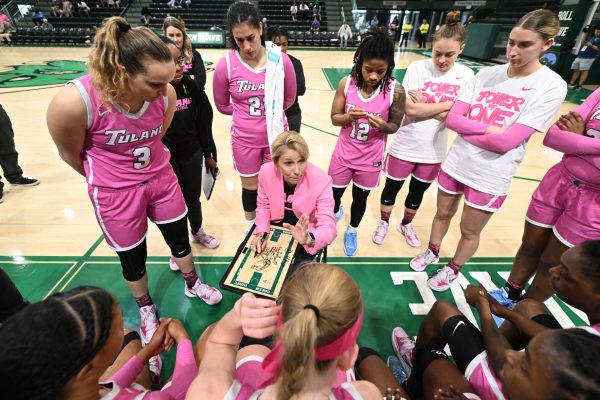‘Joker’ social critique: All set-up, no punchline
October 16, 2019

Niko Tavernise/Warner Bros
WARNING: Spoilers for “Joker” below. If you haven’t watched the movie, help yourself to any of our other quality articles.
Entering the month of October, America’s strange fascination with killer clowns continues. On Oct. 4, “Joker,” the Todd Phillips-directed origin story for Batman’s most notorious nemesis premiered in theaters across the country. Through its depiction of an almost-sympathetic murderer, “Joker” has proven an uncomfortable watch for many. More disappointing, however, is the superficial way in which the film attempts to paint its protagonist, Arthur Fleck, the nascent Joker, as the product of a sicker society.
As a cinematic piece, “Joker” admittedly finds itself in a difficult position. Both the mystery surrounding the character and his unique brand of sadism-with-a-smile have engrossed audiences since 1940. Thus, in an era of comic book spin-offs and sequels, a film tackling the origin story of one of the genre’s most psychotic creations was probably inevitable.
So too, then, was the initial backlash before its release. The Joker is famous for maiming and murdering innocent people – hardly an admirable protagonist. In the uniquely-American epoch of lone gunmen in our schools, movie theaters and places of worship, many voiced understandable fears that the film’s potential glorification of Fleck, played by Joaquin Phoenix, would inspire similar acts of violence.
#Joker on-screen evolution 1966 ➡️ 2019 pic.twitter.com/gGhp8kET3P
— Fandom, but spooky 👻 (@getFANDOM) October 16, 2019
Beyond the dangers of mythologizing random acts of wanton violence, however, lay another path for the film to choose – one of critical social introspection. The film is set in a Gotham City full of resentment. Fleck alludes to as much, asking if the world “is getting crazier.” City infrastructure is deteriorating, jobs are sparse and city residents are separated by class and race.
The film’s unwillingness to delve deeper into these issues, however, is both vexing and careless. The Joker repeatedly insists he isn’t political. Instead, his violence is the wrath of a wronged man scorned. With this approach, however, the film’s violence turns vengeful, indulgent, self-pitying and homicidal.
But despite all of this, the film presents its audience with genuine reasons to sympathize with Arthur. He is a victim of child abuse, has an unspecified mental illness and, with a neurological disorder causing him to laugh, is both isolated from and mocked by others. Worse, cuts to the city’s social services leave Arthur without both his social worker and medication.
Why the Joker movie is problematic. Rachel Miller nails it. pic.twitter.com/vTHlVOBHCY
— Heather Antos (@HeatherAntos) September 5, 2019
What, however, is the point of this sympathy? The film itself seems unsure. The scene in which Fleck, finally resolute in his villainy, prances down a set of stairs is a striking clue. Both “Joker” and its titular character revel in Fleck’s violence with no self-awareness. The victims of his murders, a treacherous coworker, a neglectful mother and Wall Street misogynists, are largely unsympathetic, making his crimes more palatable to audiences. This only underscores Fleck’s portrayal as a man who, by embracing violence, liberates himself.
Mirroring our own real-world fascination with mass murderers, Gotham only affords him respect – or fear– once he embraces his homicidal persona. This nihilism, though, simultaneously robs the film of any meaning it might have had while making it easier for disaffected individuals to project themselves onto the psychotic Fleck. The initially-timid Fleck is irrelevant to society until he gives into his worst impulses. His newfound confidence, borne of carefree killing, is therefore the self-actualization of a maligned loner, instead of a twisted response to a troubled environment.
This emptiness thus robs the film’s climax of any force it otherwise might have had. In it, the Joker asks “what do you get … when you cross … a mentally ill loner with a society that abandons him and treats him like trash?” before killing a television host on set.
Yet the film fails to clearly link Fleck’s grievances to societal failings writ large. The vast disparity in the living conditions of the impoverished Fleck and a young, affluent Bruce Wayne, for instance, underscore the class resentments which spark the third act’s protests. “Joker” refuses to engage further with its social milieu. Instead, like Fleck, it stubbornly insists on its nonpolitical nature. By refusing to grapple with the social violence which provokes mass protest in Gotham and, uncomfortable though it may be to admit, is in part responsible for Fleck’s carnage, “Joker” forgoes any claim to deeper meaning.
Todd Phillips’ #JokerMovie continues its record breaking #BoxOffice run, earning $9.72M on Monday, a new all-time record gross for a Monday in October. #Joker https://t.co/DRu3rmXCfb pic.twitter.com/bLN3KzcGcv
— International Film Critique (@IntFilmCritique) October 8, 2019
The Joker is foremost an unrepentant serial killer. As such, he does not deserve a two-hour movie of his criminal exploits. Though he is by no means a passive victim, Arthur Fleck nonetheless remains in many ways the victim of social neglect, abuse and stigma.
“Joker” would rather ignore Fleck’s social disenfranchisement. As a result, Fleck is triumphant, not tragic, and the film suffers for it. Moviegoers should have left “Joker” both disturbed by its protagonist and reflective about the social circumstances facilitating his rise. Instead, Phillips’ take on the Clown Prince of Crime ultimately falls flat.





















Melissa • Nov 6, 2019 at 2:36 am
I agree. It’s better a movie doesn’t try to explain how the Joker came to be. Much better to have him just show up and kill people with no origin story.
You’re so insightful. Why don’t you write and direct a better movie.
Betty Lowell • Oct 20, 2019 at 6:38 am
Thank you for a clear characterization of the film Joker, and the mindless numbing of any value inherent in it. Societal ills are problematic and need to be addressed, however the cause of his disturbing and horrific behavior goes much deeper. When I watch a movie, I want to know the protagonist experiences unfairness, grief and loss, as we all do, and is able to be triumphant over it. Good job in exposing Joker for what it is! There are good movies out there, and this isn’t one of them.